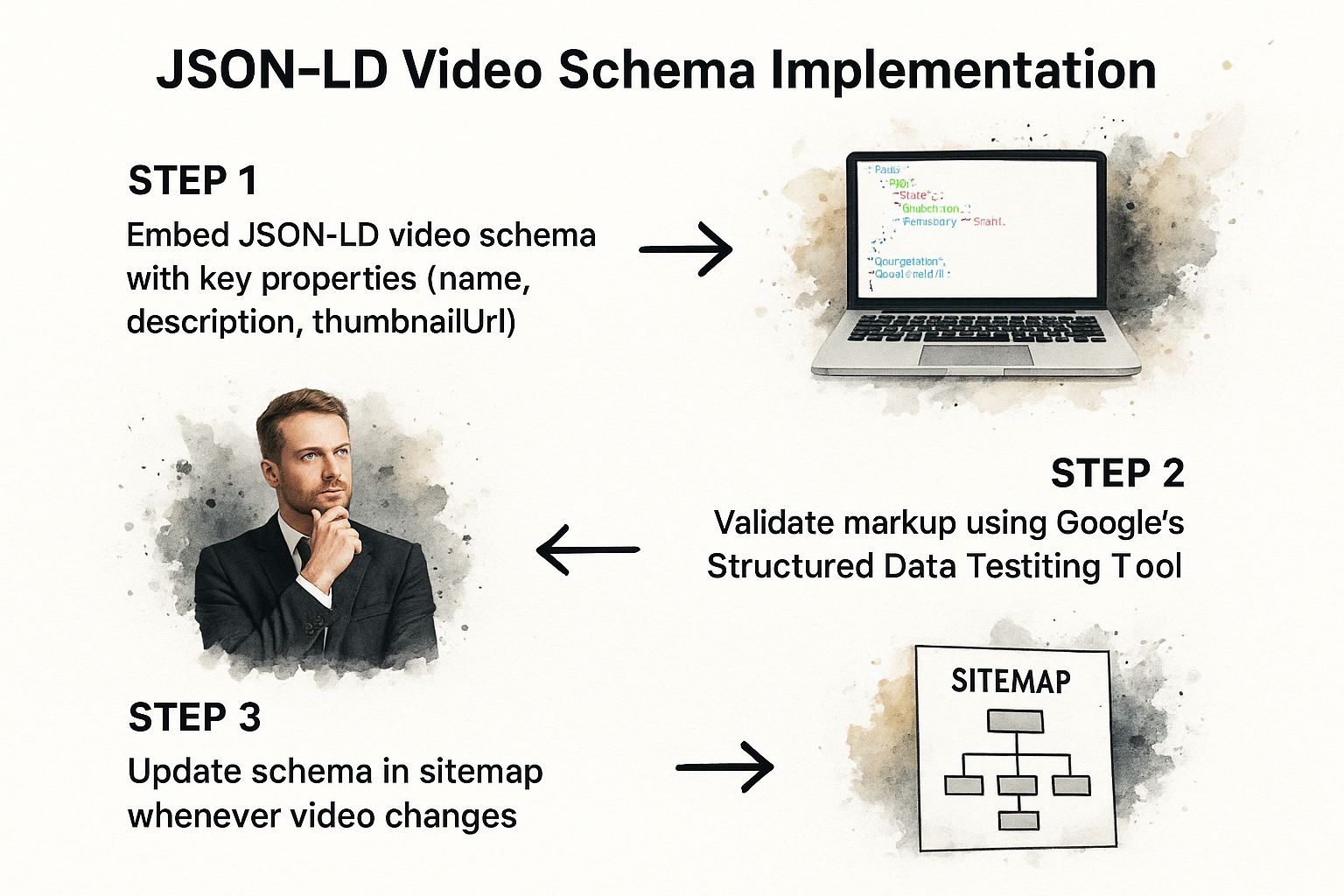In This Article
Subscribe to our newsletter
Unleash Your Video's Potential: A Guide to Video SEO Mastery
Want your videos to rank higher and attract more viewers? This listicle delivers seven powerful video SEO tips to boost your video's visibility and engagement in 2025 and beyond. Learn how to optimize titles, descriptions, tags, transcripts, schema markup, sitemaps, video length, engagement metrics, and thumbnails for maximum impact. Effective video SEO is crucial for reaching your audience in today's competitive content landscape. These actionable strategies will transform your videos into SEO powerhouses, regardless of your video marketing experience.
1. Optimize Video Title, Description, and Tags
Optimizing your video title, description, and tags is the cornerstone of any successful video SEO strategy. This fundamental practice involves strategically incorporating relevant keywords into these text-based elements, allowing search engines to understand your video's content and rank it accordingly. Think of these elements as your video's resume for search engines – they need to be compelling and informative to grab attention and showcase relevance. Without proper metadata optimization, your video content, no matter how high-quality, might be lost in the vast digital library of the internet. This is why metadata optimization for both search engines and viewers is key for improving video SEO.

Successful YouTubers like MrBeast exemplify the power of this technique. His highly clickable titles, such as "I Gave $1,000,000 To People Who...", incorporate targeted keywords while remaining engaging and attention-grabbing. This approach effectively combines video SEO tips with audience appeal. Similarly, marketing expert Neil Patel utilizes comprehensive descriptions with timestamps and relevant links, providing viewers with valuable context and further resources. These examples demonstrate how proper optimization caters to both search algorithms and the user experience. Learn more about Optimize Video Title, Description, and Tags
This approach is especially valuable for publishers, media companies, content creation teams, ad sales teams, editorial teams, e-commerce teams, and digital marketing teams aiming to expand their reach and drive engagement. Optimizing your video metadata significantly improves discoverability in search results, allowing your target audience to find your content more easily. It also helps algorithms understand the context of your content, ensuring it's served to the right audience. Moreover, optimizing these elements is a relatively low-effort task that can yield a high impact on your video's performance.
Here are some actionable video SEO tips:
- Title: Use your primary keyword within the first 60 characters of your title. This ensures it’s visible in search results, especially on mobile devices.
- Description: Write detailed descriptions of at least 200 words, incorporating keywords naturally within the text. Including timestamps and links can further enhance the user experience.
- Tags: Include 5-7 relevant tags, ranging from specific to broader terms related to your video's topic. Researching competitors' videos can provide valuable keyword inspiration.
- Thumbnails: Create custom thumbnails with descriptive file names incorporating relevant keywords.
While highly effective, this method also has potential drawbacks. Overdoing keyword optimization can lead to keyword stuffing, which can negatively impact your rankings. It also requires ongoing keyword research to stay up-to-date with current search trends. Furthermore, the effectiveness of these video SEO tips can vary across different platforms.
Despite these potential cons, optimizing your video title, description, and tags remains a cornerstone of effective video SEO. By understanding its principles and implementing the provided tips, you can significantly enhance your video's visibility, reach a wider audience, and ultimately achieve your content marketing goals.
2. Create Detailed Video Transcripts
Creating detailed video transcripts is a crucial video SEO tip that significantly boosts your content's discoverability and accessibility. This process involves converting your video's audio into a text-based document that search engines can crawl and index. Essentially, it's like giving search engines a written version of your video, allowing them to understand its content and rank it appropriately for relevant searches. This is essential for any successful video SEO strategy.
This method works by providing search engines with indexable content. While they are getting better at understanding audio and video content directly, text remains the most reliable way for them to grasp the nuances of your message. Transcripts expand your content’s searchability by giving search engines more text to analyze and match with user queries. Moreover, transcripts make your videos more accessible to a wider audience, including those with hearing impairments or who prefer to read content. They also offer the opportunity for viewers to quickly scan the content of a video before deciding to watch.
Features of a good video transcript include:
- Full Text Representation: Accurate transcription of all spoken words and important non-verbal cues.
- Indexable Content: Formatted in a way that search engines can easily crawl and index.
- Accessibility Enhancement: Supports closed captions and screen reader compatibility.
- Flexible Display: Can be displayed as closed captions within the video or as separate text alongside it.
Pros:
- Significantly increases the SEO footprint of your videos, leading to higher search rankings.
- Improves accessibility and user experience for a broader audience.
- Can be repurposed into blog posts, social media updates, or other written content.
- Helps international audiences understand content, even with language barriers.
Cons:
- Can be time-consuming to create accurate transcripts for long videos.
- Automated transcriptions often require editing for accuracy, particularly with industry-specific jargon.
- May add to page load time if embedded as text directly on the page.
Examples of successful implementation include TED Talks, which provides interactive transcripts for all its videos, boosting SEO while enhancing user experience. Similarly, Moz's Whiteboard Friday videos include full transcripts below each video, allowing for better indexing and searchability. These organizations recognize the power of transcripts for both SEO and accessibility.
Actionable Tips for Creating Effective Video Transcripts:
- Use AI Transcription Tools: Leverage AI-powered transcription tools like Otter.ai or YouTube's built-in automatic captioning feature to create a first draft. This significantly speeds up the process.
- Edit for Accuracy: Carefully review and edit the automated transcript for accuracy, paying close attention to industry-specific terms and nuances in language.
- Structure and Format: Enhance readability by structuring the transcript with headers, paragraphs, and proper formatting. This improves both user experience and SEO.
- On-Page Placement: Include the transcript on the same page as the video for maximum SEO benefit. Search engines can directly connect the text with the video content.
- Schema Markup: Implement schema markup to clearly indicate to search engines the presence of a transcript. This helps them understand the relationship between the video and its text equivalent.
When and Why to Use Video Transcripts:
Use this approach for any video content you publish online, especially if you are aiming for organic reach and improved accessibility. This is particularly important for educational videos, product demos, interviews, and any content where the spoken words are crucial to understanding the message. For publishers, media companies, content creation teams, ad sales teams, editorial teams, e-commerce teams, and digital marketing teams, video transcripts are an indispensable tool for maximizing the impact and reach of your video content. Learn more about Create Detailed Video Transcripts and explore how AI captions can further enhance accessibility, engagement, and SEO.
This item deserves its place on the list of video SEO tips because it addresses two key aspects: discoverability and accessibility. By providing both search engines and users with a text-based version of your video content, you significantly improve the chances of your video ranking well in search results and reaching a wider audience. This translates directly into increased visibility, engagement, and ultimately, a stronger ROI on your video marketing efforts. Popularized by influencers like Rand Fishkin (formerly of Moz), TED Talks, and HubSpot Academy, the use of video transcripts is a proven strategy for optimizing video content for both search engines and users.
3. Implement Video Schema Markup
Boosting your video's visibility in search results is a crucial aspect of video SEO. Schema markup, a powerful yet often overlooked technique, can significantly improve how search engines understand and display your video content. By adding this structured data code to your webpage, you provide search engines with detailed information about your video, increasing the likelihood of earning rich snippets—visually appealing search results that include video thumbnails, duration, and other key information. These rich snippets can dramatically improve click-through rates and drive more traffic to your videos.

The infographic above visualizes the process of implementing schema markup for your videos, highlighting key steps from identifying video content to validating the implemented schema.
Schema markup uses a standardized format recognized by major search engines like Google, Bing, Yahoo, and Yandex. This allows you to provide metadata such as video duration, upload date, description, and even specify schema types like VideoObject for general videos or BroadcastEvent for live streams. For publishers, media companies, and e-commerce teams, this translates into better visibility in video search results, enhanced appearance with eye-catching thumbnails, and ultimately, increased organic traffic. Content creation, editorial, ad sales, and digital marketing teams can leverage schema to ensure their video content reaches a wider audience.
The following infographic illustrates the workflow for implementing video schema markup:

As depicted in the infographic, implementing schema markup starts with identifying the relevant video content and choosing the appropriate schema type. It then guides you through adding the schema to your website, testing its validity, and finally, monitoring its performance. The sequential flow emphasizes the importance of each step in ensuring your schema markup is correctly implemented and effective. Specifically, validation is a crucial step, ensuring error-free implementation for optimal search engine interpretation.
Companies like Wistia and Food Network have seen significant success with video schema. Wistia reported a 21% increase in organic traffic after implementing video schema across their platform, showcasing the direct impact on visibility and reach. Food Network utilizes video schema for their recipe videos, resulting in prominent video rich snippets appearing in recipe searches, thus driving significant traffic to their website.
Here are some actionable tips to implement video schema effectively:
- Use Google's Structured Data Testing Tool: This tool allows you to validate your schema implementation and identify any errors.
- Include Essential Properties: Ensure you include properties like
name,description,thumbnailUrl,uploadDate, anddurationfor comprehensive video information. - JSON-LD Format: Consider using JSON-LD, Google's preferred schema format, for easier implementation and maintenance.
- Video Sitemap Integration: Add schema markup to your video sitemap for even better SEO performance.
- Maintain and Update: Keep your schema updated when you make significant changes to your video content.
While schema markup offers substantial benefits, it's important to be aware of the potential drawbacks. Implementation can be technically challenging for beginners, requiring some understanding of HTML or website platforms. Additionally, schema requires maintenance when video content changes, and there's no guarantee of rich snippet display even with perfect implementation. However, the potential benefits far outweigh the challenges. Implementing video schema markup deserves a prominent place in any video SEO strategy due to its potential to significantly improve visibility and drive traffic. The enhanced search appearance with rich snippets makes your video content more enticing to users, increasing the chances of clicks and engagement. By providing more context to search engines, you're not just optimizing for algorithms, you're optimizing for users, creating a better search experience and increasing your chances of video SEO success.
4. Create and Submit a Video Sitemap
Boosting your video's visibility in search results requires a strategic approach to SEO. One crucial tactic, often overlooked, is creating and submitting a video sitemap. This powerful tool can significantly enhance your video SEO efforts, making it a must-have for anyone serious about video marketing.
A video sitemap is essentially an XML file that acts as a roadmap for search engines, guiding them to all the video content on your website. Unlike standard sitemaps that simply list URLs, a video sitemap provides detailed metadata about each video, including the title, description, duration, thumbnail URL, and more. This rich information makes it easier for search engines like Google to understand the context of your videos, index them correctly, and ultimately, display them in relevant search results.
Why a Video Sitemap Deserves a Place in Your Video SEO Strategy
Search engine crawlers do their best to discover content organically, but they don't always catch everything. A video sitemap acts as a fail-safe, ensuring search engines don't miss your valuable video content, especially content embedded within Flash players or dynamically loaded content. It gives you greater control over how your videos appear in search, leading to more accurate and compelling search snippets.
Features and Benefits of Video Sitemaps
Video sitemaps utilize a specific XML format following Google's video sitemap protocol. They contain crucial video-specific metadata such as:
- Title and Description: Provide context and keywords for search engines.
- Duration: Helps users gauge video length.
- Thumbnail URL: Provides a visual representation of your video in search results, increasing click-through rates.
- Content Location: Specifies the actual video file URL.
- Publication Date and Age Restrictions: Further refine indexing and targeting.
- Category and Tags: Provide thematic context to your videos.
Implementing a video sitemap offers numerous advantages:
Pros:
- Significantly increases the chances of your video content being properly indexed by search engines.
- Helps your videos surface in video-specific search results, expanding your reach.
- Catches video content that regular crawling might miss.
- Provides more control over how your videos are presented in search results.
Cons:
- Requires some technical knowledge to create and maintain, though tools can simplify the process.
- Must be updated regularly as new content is published or existing content changes.
- Benefits may be limited if you only have a few videos on your site.
Real-World Examples:
Major media outlets like The New York Times leverage comprehensive video sitemaps to ensure their extensive video libraries are readily discoverable by search engines. Online learning platforms such as Coursera have also reported significant success with video sitemaps, seeing increases in video search traffic after implementation.
Actionable Tips for Implementation:
- Utilize Sitemap Generator Plugins: If you're using WordPress, plugins like Yoast SEO Premium and All in One SEO (AIOSEO) offer user-friendly video sitemap generation features.
- Prioritize Essential Metadata: Include the most important metadata (title, description, thumbnail) to avoid overly complex sitemaps.
- Adhere to Sitemap Limits: Limit your video sitemap to 50,000 videos per file. If you have more videos, create multiple sitemaps.
- Submit via Google Search Console: Once created, submit your video sitemap through Google Search Console to ensure Google is aware of it.
- Establish a Regular Update Schedule: Set up regular sitemap updates, ideally coinciding with your video publishing schedule.
When to Use a Video Sitemap:
If you're serious about video SEO and want to maximize the discoverability of your video content, a video sitemap is essential. Whether you're a publisher, media company, content creator, or e-commerce business, if video is a part of your content strategy, a video sitemap is a valuable tool. While the benefits might be less pronounced for websites with only a handful of videos, the effort required to create and maintain a video sitemap is minimal compared to the potential rewards. This makes it a worthwhile investment for virtually any website featuring video content.
5. Optimize Video Length and Engagement Metrics
Video SEO isn't just about keywords; it's about keeping viewers glued to their screens. Optimizing video length and engagement metrics like watch time, retention rate, likes, and comments is crucial for boosting your video's visibility. Search engines and social media algorithms prioritize videos that hold audience attention and generate interaction. This translates to better rankings in search results and increased exposure through recommendations, ultimately driving more organic traffic to your content.

This approach works because platforms like YouTube, TikTok, and Instagram use engagement metrics as key indicators of content quality. High retention rates and active comment sections signal to the algorithm that your video is valuable and deserves to be shown to a wider audience. While the ideal video length varies depending on the platform and the type of content, the underlying principle remains the same: captivate your audience and encourage them to interact.
For example, educational YouTube channel Veritasium found that their in-depth science videos, often exceeding 15-20 minutes, outperform their shorter content in terms of both engagement and search visibility. Conversely, HubSpot’s analysis revealed that their marketing tutorial videos, clocking in between 7-15 minutes, achieved a 50% higher retention rate compared to longer formats. These examples highlight the importance of platform-specific length optimization.
Actionable Tips for Optimizing Video Length and Engagement:
- Platform-Specific Length: YouTube favors videos over 10 minutes, while TikTok thrives on short-form content under 60 seconds, and Instagram prefers videos under 2 minutes. Tailor your video length to the platform's algorithm and audience expectations.
- Front-Load Key Information: Grab viewers' attention in the first 15 seconds by presenting the most compelling information upfront. This "hook" is essential for maximizing retention.
- Calls to Action (CTAs): Encourage interaction by incorporating clear CTAs throughout the video, prompting viewers to like, comment, subscribe, and share.
- Analyze Retention Graphs: Use platform analytics (like YouTube Studio) to identify drop-off points in your videos. This data provides valuable insights into what's working and what needs improvement in future content.
- A/B Test Video Lengths: Experiment with different video lengths for similar content to determine your audience's sweet spot. This data-driven approach allows for continuous improvement.
- Track and Analyze Engagement: Monitor metrics like watch time, average view duration, and audience retention to understand how viewers are interacting with your content. Use this information to refine your video SEO strategy.
Pros of Optimizing Video Length and Engagement:
- Improved Algorithm Performance: Higher engagement signals lead to better visibility across platforms.
- Better Search Rankings: Increased retention rates contribute to higher search rankings.
- Boosted Visibility: Engagement metrics like comments and shares amplify your video's reach.
- Data-Driven Improvement: Analyzing engagement data enables continuous optimization.
Cons of Optimizing Video Length and Engagement:
- Variable Optimal Length: Finding the ideal video length requires research and experimentation.
- Ongoing Analysis: Regular monitoring and adjustments are necessary.
- Content Restructuring: Significant content revisions may be required to optimize for engagement.
- Balancing Engagement and Depth: Prioritizing engagement can sometimes compromise the educational depth of your content.
This item deserves its place in the list of video SEO tips because it directly impacts how search engines and social media platforms perceive and rank your content. By understanding and optimizing for video length and engagement metrics, you can significantly improve your video's visibility, reach a wider audience, and ultimately achieve your video marketing goals. This method is particularly relevant for Publishers, Media Companies, Content Creation Teams, Ad Sales Teams, Editorial Teams, E-commerce Teams, and Digital Marketing Teams looking to maximize the impact of their video content. This approach has been popularized by resources like the YouTube Creator Academy and influential creators like MrBeast (Jimmy Donaldson), and discussed by industry experts like Social Media Examiner.
6. Optimize Video Thumbnails for Click-Through Rate
Custom video thumbnails are essentially visual headlines for your videos. They're the first thing potential viewers see in search results and platform feeds, playing a crucial role in whether someone clicks to watch your content. A well-optimized thumbnail can dramatically improve click-through rates (CTR), indirectly boosting video SEO performance. Higher engagement metrics like CTR signal to search and platform algorithms that your content is valuable and relevant, ultimately leading to improved visibility. This is a vital aspect of any comprehensive video SEO strategy.

This approach leverages several key features for optimal results: high-resolution custom images (at least 1280x720px) are essential for clear visuals; maintaining brand-consistent visual elements across thumbnails builds recognition; strategic use of text overlays conveys key information quickly; color psychology can be implemented to attract attention and evoke specific emotions; and A/B testing capabilities allow you to refine your approach over time.
Think of popular creators like Marques Brownlee (MKBHD). His consistent, minimalist thumbnails with bold colors have become instantly recognizable in tech video searches, proving the power of a strong visual brand. Similarly, Tasty food videos often use bright, close-up images of finished dishes, and these consistently outperform stock thumbnails in A/B tests, demonstrating the effectiveness of visually appealing imagery.
Why and When to Optimize Thumbnails:
Thumbnail optimization should be considered a non-negotiable part of your video SEO tips checklist. It's relevant for any video content published online, whether on YouTube, social media platforms, or embedded on your website. Implement this from the moment you begin creating video content to maximize its potential reach.
Actionable Tips for Thumbnail Optimization:
- Human Element: Include close-up human faces showing emotion when relevant. Studies show this can increase CTR by up to 38%.
- Concise Text: Limit text overlays to 3-4 words maximum, using large, clear fonts.
- Color Contrast: Use contrasting colors that stand out in a crowded feed.
- Accuracy: Ensure the thumbnail accurately represents the video content to maintain viewer trust and avoid clickbait.
- Brand Consistency: Create a consistent thumbnail style guide for brand recognition.
- A/B Testing: Test multiple thumbnails for the same video to identify what resonates with your audience and drives clicks.
- Keyword Integration: Name image files with relevant keywords before uploading for an additional SEO benefit.
Pros and Cons:
- Pros: Significantly improves CTR (often by 30-40%), creates strong brand recognition, helps the target audience quickly identify relevant content, provides context that the title alone might not convey.
- Cons: Can lead to clickbait if not representative of the video content, requires graphic design skills or resources, text on thumbnails may not be fully visible on smaller mobile screens, what works aesthetically changes over time as platform designs evolve.
By understanding the importance of optimized thumbnails and implementing these video SEO tips, content creators, publishers, and marketing teams can significantly improve the visibility and performance of their video content. Learning from examples like Peter McKinnon's photography tutorials, Canva's thumbnail templates, and YouTube Creator Academy's best practices will provide further guidance in developing a winning thumbnail strategy.
7. Host Videos for Maximum Crawlability
Where and how you host your videos plays a crucial role in your overall video SEO strategy. This seemingly technical aspect significantly impacts how search engines discover, crawl, and index your video content, ultimately affecting its visibility in search results. Effectively hosting videos for maximum crawlability involves understanding the technical nuances of page loading speed, embedding methods, and choosing the right hosting platform. This is a critical component of any successful video SEO tips list.
Hosting your videos strategically improves their discoverability and ensures they contribute to your website's overall SEO performance. It directly influences how search engine crawlers interpret and index your content. Choosing the right approach, be it self-hosting or leveraging a third-party platform, can significantly impact your video's reach and effectiveness. Learn more about Host Videos for Maximum Crawlability to delve deeper into the technical aspects.
Self-Hosting vs. Third-Party Platforms:
Deciding between self-hosting and using platforms like YouTube or Vimeo is a key consideration. Self-hosting offers greater control over branding, monetization, and data collection, but requires technical expertise and robust server infrastructure. Third-party platforms provide wider reach and easier embedding, but may limit customization and control. Implementing a Content Delivery Network (CDN) is essential for both methods to ensure fast loading speeds globally.
Embedding Techniques and Mobile Optimization:
Using SEO-friendly embedding techniques is crucial for passing link equity and ensuring search engines can properly index your videos. Avoid JavaScript or Flash-based embeds, opting instead for iframe embed codes, particularly when embedding from external sources like YouTube. Mobile-friendly video delivery, achieved through adaptive bitrate streaming and video compression optimization, guarantees a seamless viewing experience across different devices and connection speeds, further boosting user engagement and SEO performance.
Pros of Proper Video Hosting:
- Improved Page Load Speed: A key ranking factor, faster loading times enhance user experience and SEO.
- Increased Visibility: Choosing the right platform can boost visibility in platform-specific searches (like YouTube).
- SEO-Friendly Embedding: Retains link equity and improves crawlability.
- Enhanced User Experience: Optimized hosting contributes to positive user experience signals, indirectly influencing SEO.
Cons of Different Hosting Approaches:
- Self-Hosting: Requires technical expertise, server resources, and bandwidth management.
- Third-Party Hosting: May limit branding opportunities and control over video player customization.
- External Embeds: Can introduce performance issues if not implemented correctly.
- Platform Dependence: Changes in third-party platform algorithms or policies can impact your SEO strategy.
Examples of Successful Implementation:
- Wistia client Unbounce saw a 30% increase in organic traffic after transitioning from YouTube embeds to SEO-optimized Wistia hosting, demonstrating the benefits of a dedicated video hosting platform.
- Moz utilizes a hybrid approach: leveraging YouTube for maximum discovery while also self-hosting versions on their website for improved website SEO, demonstrating a strategic balance between reach and control.
Actionable Tips for Optimized Video Hosting:
- Strategic Self-Hosting: Self-host crucial videos on your most valuable landing pages for maximum SEO benefit.
- SEO-Friendly YouTube Embeds: Use the SEO-friendly iframe embed code for YouTube videos on your site.
- Same Domain Hosting: When possible, host the video on the same domain as its landing page to consolidate SEO value.
- Lazy Loading: Implement lazy loading for videos placed lower on a page to improve initial page load speed.
- Adaptive Bitrate Streaming: Optimize video delivery for different devices and internet connections.
- Specialized Video Hosting: Consider services like Wistia or Brightcove for enhanced features and business-focused video SEO.
- Caching Strategies: Implement proper caching for self-hosted videos to further optimize delivery speed.
By prioritizing video hosting best practices, you can significantly improve your video SEO performance and ensure your content reaches the widest possible audience. For publishers, media companies, content creation teams, ad sales teams, editorial teams, e-commerce teams, and digital marketing teams, understanding these nuances is critical for maximizing the ROI of video content.
7 Key Video SEO Tips Comparison
| Tip Title | Implementation Complexity 🔄 | Resource Requirements ⚡ | Expected Outcomes 📊 | Ideal Use Cases 💡 | Key Advantages ⭐ |
|---|---|---|---|---|---|
| Optimize Video Title, Description, and Tags | Low - mainly keyword research and text editing | Low - time for keyword research and writing | Improved video discoverability and ranking | Any video content aiming for higher search visibility | High impact with low effort; aids algorithm understanding |
| Create Detailed Video Transcripts | Medium - requires transcription and editing | Medium - transcription tools, editing time | Expanded SEO footprint; improved accessibility | Videos targeting wider or international audiences; accessibility focus | Boosts SEO and accessibility; content repurposing potential |
| Implement Video Schema Markup | High - requires technical knowledge of structured data | Medium - developer or SEO specialist time | Enhanced SERP appearance; possible rich snippets | Websites with dedicated video pages; aiming for rich search features | Increased visibility with rich snippets; better search engine context |
| Create and Submit a Video Sitemap | Medium-High - technical XML sitemap creation | Medium - technical skills and maintenance | Better indexing by search engines | Large video libraries or websites with frequent video updates | More control over video indexing; supports video search results |
| Optimize Video Length and Engagement Metrics | Medium - requires ongoing data analysis and content adjustment | Medium - analytics tools and content planning | Higher retention, improved rankings | Content creators focused on engagement and audience retention | Improves algorithm signals; data-driven content optimization |
| Optimize Video Thumbnails for Click-Through Rate | Low-Medium - graphic design skills needed | Medium - design resources; A/B testing time | Increased click-through rates | Channels prioritizing viewer acquisition and brand consistency | Significant CTR boost; strong brand identity building |
| Host Videos for Maximum Crawlability | Medium-High - technical setup and hosting decisions | High - hosting costs, bandwidth, and expertise | Faster page load, better indexing, improved UX | Business sites with custom video hosting needs | Improves load speed and SEO; retains SEO value through embedding |
Ready to Rank? Take Action and Watch Your Videos Soar
Optimizing your videos for search engines is no longer a luxury but a necessity in today's digital landscape. From crafting compelling titles and descriptions to leveraging video schema markup and sitemaps, the video SEO tips we've covered in this article provide a robust foundation for boosting your video visibility. Mastering these concepts is crucial for driving organic traffic, increasing audience engagement, and ultimately, achieving your video marketing goals. Remember, high-ranking videos translate to greater brand awareness, improved lead generation, and increased conversions.
Before you publish your videos, make sure you've covered all your bases. Using a comprehensive video optimization checklist can help ensure your videos are fully optimized for search engines. This Video Optimization Checklist: Boost Video Success from revid.ai will provide valuable support in streamlining your workflow. The most important takeaways to remember are optimizing for both search engines and viewers, focusing on user experience, and consistently tracking your results. By diligently applying these video SEO tips and adapting your strategies as needed, you can ensure your content reaches its full potential and connects with your target audience effectively.
Ready to streamline your video SEO workflow and amplify your video's reach? Aeon simplifies video creation and optimization, empowering you to produce high-quality, SEO-friendly content at scale. Explore Aeon today and unlock the full potential of your video marketing strategy.






.jpg)